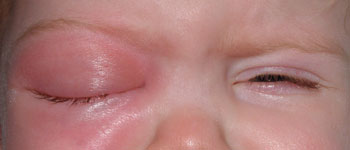Orbital Cellulitis
Bacterial or fungal infection of lids and orbital tissues In children, usually arises from spread of infection from blocked and infected ethmoid sinus In children or adults, may arise from infected lid skin wound Otherwise rare in immune-competent, non-diabetic adults In diabetic, elderly, and otherwise immune-compromised adults, fungal infection (aspergillosis, mucormycosis) must be considered May be restricted to tissues in front of orbital septum ("pre-septal cellulitis ") or, more dangerously, involve tissues behind orbital septum ("post-septal cellulitis ") Untreated infection may spread to intracranial space, leading to meningitis, cavernous sinus thrombosis
Diffuse, balloon-like swelling and violet discoloration of upper and lower lids Eye pain Tenderness to touch of lids Mildly engorged conjunctival vessels Proptosis (in "post-septal cellulitis") Reduced eye movements (in "post-septal cellulitis") Diplopia (in "post-septal cellulitis") Reduced vision (in "post-septal cellulitis") Concurrent ethmoid sinusitis in children Immune compromise, diabetes, vaso-occlusive process, face trauma, cancer in adults
Order sino-orbital imaging studies to rule out sinusitis, orbital subperiosteal abscess, or tumor In children, if imaging shows ethmoid sinusitis, treat with intravenous antibiotics aimed at streptococcus, staphylococcus If no improvement within 2 days, surgical sinus drainage may be necessary Subperiosteal abscess may require surgical orbital drainage In adults, imaging and sinonasal biopsy aimed at diagnosing fungal infection, especially in immunocompromised hosts; treatment depends on findings
In immune-competent children with ethmoid sinusitis, systemic antibiotic treatment usually rapidly resolves all manifestations with no damage, but orbital abscess drainage and sinus surgery may be necessary In adults, outcome depends on extent and type of infection and predisposing conditions
